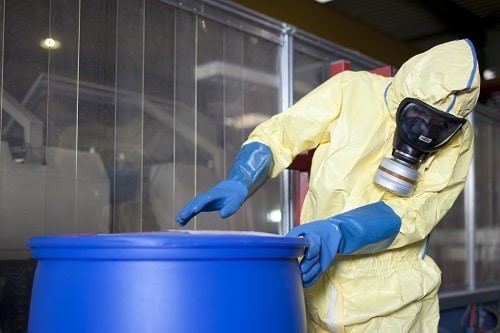UK businesses may have to continue to meet any future new European Union exposure limits for carcinogenic substances at work if they are to avoid compensation claims.
Features
Cancer-causing substances: what will Brexit mean?
Brexit is possibly the most complex divorce in modern constitutional history. It is a paradise for academic lawyers and an absolute nightmare for many others. Whatever the merits of our past relationship with Europe, like may divorces, the devil lies in the detail.
One important detail that seems still to be resolved is our response to how changes in our understanding of cancer-causing chemicals should be translated into prevention in the workplace.
 Over the years, the Carcinogens and Mutagens Directive has enabled European countries to translate the latest medical discoveries about cancer-causing chemicals into practical protection in the workplace. Photograph: iStock
Over the years, the Carcinogens and Mutagens Directive has enabled European countries to translate the latest medical discoveries about cancer-causing chemicals into practical protection in the workplace. Photograph: iStock
Over the years, the scary-sounding Carcinogens and Mutagens Directive has enabled European countries to translate the latest medical discoveries about cancer-causing chemicals into practical protection in the workplace.
It is a slow process, but not as slow as the international process through the International Agency for Research on Cancer.
Over the last few years, the process – administered now through the Risk Assessment Committee of the European Chemicals Agency (ECHA) – has identified where the science indicates the need to reduce occupational exposure limits (OELs) in relation to several chemicals, ranging from the rare to the commonplace.
OELs, of course, mean different things to different countries. In some European countries, an OEL is the threshold at which a business can be prosecuted for
threatening someone’s health. In others, it is part of a mixed bag of measures which, taken together, are indicators of an employer’s overall compliance with health protection requirements.
 In some European countries, an OEL is the threshold at which a business can be prosecuted for threatening someone’s health. Photograph: iStock
In some European countries, an OEL is the threshold at which a business can be prosecuted for threatening someone’s health. Photograph: iStock
In the UK, an OEL is certainly not meant as simply the maximum exposure limit that employers should ensure they do not breach, with no regard to their overall attempts to reduce exposure to the cancer-causing substance. In fact, in the UK, the employer’s legal duty is to aim to reduce workers’ exposure to cancer-causing chemicals as low as reasonably possible (ALARP) below the OEL.
With the move from the European Union (EU) regime following Brexit, the question has been posed as to whether OELs are really all that relevant to the UK, if we continue along the ALARP route. The answer, from a legal perspective is an emphatic ‘yes’.
While for the Health and Safety Executive (HSE) OELs may or may not feature in the forefront of considerations for enforcement, in civil law cases the OEL will continue to be a really important benchmark – even if they are not legally set by the UK.
This is because the ECHA-set OEL provides a benchmark of what is a reasonably foreseeable level of exposure which may result in disease. So, even if a UK employer does not have a regulatory duty to meet an OEL, they cannot argue that they have taken reasonable care if they fail to meet an OEL and, as a consequence, someone develops cancer.
In legal terms, they would be liable in the tort of negligence, meaning they could be subject to a civil claim for personal injury compensation from the affected worker. So, in practical terms, employers may therefore seek to meet any OEL regardless of whether it is legally required under future UK health and safety law.
In the event of a civil legal claim, the full cost of foreseeable illness must be footed by the liable employer. An individual’s life worth of living with and then dying of cancer can result in liability into the millions.
We can see how non-regulatory OELs (i.e. OELs that are not a legal requirement) are used as the benchmark of civil liability from benzene cases over the last decade in some US states which follow similar legal principles to the UK. In those cases, companies which were compliant with local regulatory standards – but which did not match the OEL levels of other businesses who worked to European or other standards – found themselves liable in ‘toxic tort’ litigation.
Thus, regardless of the UK’s future regulatory regime for the control of exposure to cancer-causing substances at work, OELs from Europe may be of real importance when determining the balance sheet, as well as the moral responsibility of businesses in the UK.
Looking at the specifics of the Carcinogens and Mutagens Directive, there are certainly some substances to watch, for which the EU may adopt new OELs. These substances are benzene, nickel and acrylonitrile. According to the European Commission, this would affect people working in industries as diverse as car maintenance, through to electronics manufacturing and the fur industry.
According to the ECHA, these substances cause a range of cancers – including breast cancer, brain and stomach cancers – as well as leukaemia and miscarriage. The European Commission has proposed an amendment to the Carcinogens and Mutagens Directive for these three substances which may not now take legal effect in the UK, due to Brexit.
“Since Brexit, UK guidance on these substances might not be informed by the latest research about cancer risks in humans,” comments Kelvin Williams, president of the British Occupational Hygiene Society. “Published government guidance on acrylonitrile, for example, references the International Agency for Research on Cancer (IARC), saying that acrylonitrile is only a possible human carcinogen.
However, last year IARC’s own expert committee stated that the evidence is now that it probably does cause cancer in men and women and has recommended work to formally raise its risk level. However, this could take IARC several years. The European Commission has done this work already. Given how widely people are exposed to these substances, those years of difference could translate into hundreds of deaths.”
Some of the cancer-causing chemicals that the UK has accepted need to be subject to stricter exposure controls at work might now no longer be subject to planned controls.
The European Council agreed changes to an earlier list of controls for 13 cancer-causing substances while the UK was still a member of the EU. The UK agreed that limits on these 13 cancer-causing substances needed to be put in place to protect workers but argued for more time for their implementation. There is now no legal obligation on the UK to change those 13 OELs following our departure from the EU.
One of the substances is formaldehyde, which is widely used in the funeral industry to enable dignified burial. The UK government had argued that it would take until 2024 for the UK industry to protect funeral home workers from cancer-causing levels of the substance, delaying the implementation of the safeguards. It is unclear whether this standard will now be changed in the UK.
Another area where the EU has proposed to make inroads in protecting workers relates to cytotoxic drugs, which are widely used by healthcare professionals and vets in cancer treatments. Health professionals have already highlighted that protecting the workers who treat cancer from increased cancer risks should be on the agenda, regardless of the impact of Brexit.
The uncertainty of the legal situation and the emerging regulatory picture around cancer-causing chemicals will doubtless disappear in coming months. In the meantime, an eye to European exposure standards remains the advice from many occupational disease lawyers.
Professor Kevin Bampton is CEO of the British Occupational Hygiene Society (BOHS)
FEATURES

Making a drama out of conflict training
By Nicole Vazquez, Worthwhile Training on 02 May 2024
Conflict management training can give workers the skills and confidence to defuse or manage aggressive behaviour from customers, service users and the public, but it needs to be relevant, realistic and appropriate for the individual’s level of experience and capabilities.

Backstage pass: how do festival organisers keep staff and visitors safe?
By Kerry Reals on 29 April 2024
As festivalgoers prepare to pull on their wellies, dig out their sunhats and dust off their tents ahead of another summer of live outdoor events, Safety Management looks behind the scenes at how festival organisers keep the armies of workers tasked with setting everything up safe and well.

AI: a powerful new tool for managing safety risks
By Robert Leech, EcoOnline on 29 April 2024
AI-driven technology is revolutionising the management of occupational safety and health, making it easier to spot hazards, predict unsafe behaviours and take preventative action to protect workers.



